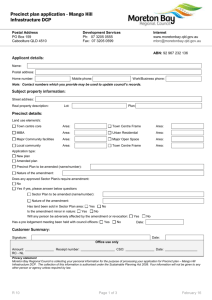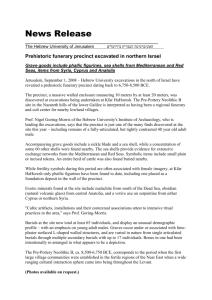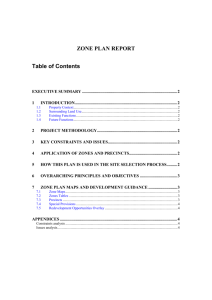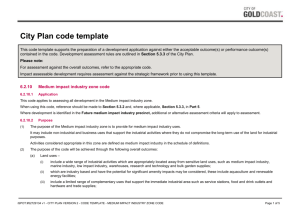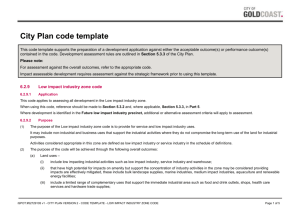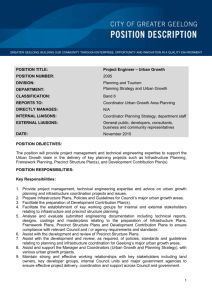Urban Growth Zone - Department of Transport, Planning and Local
advertisement
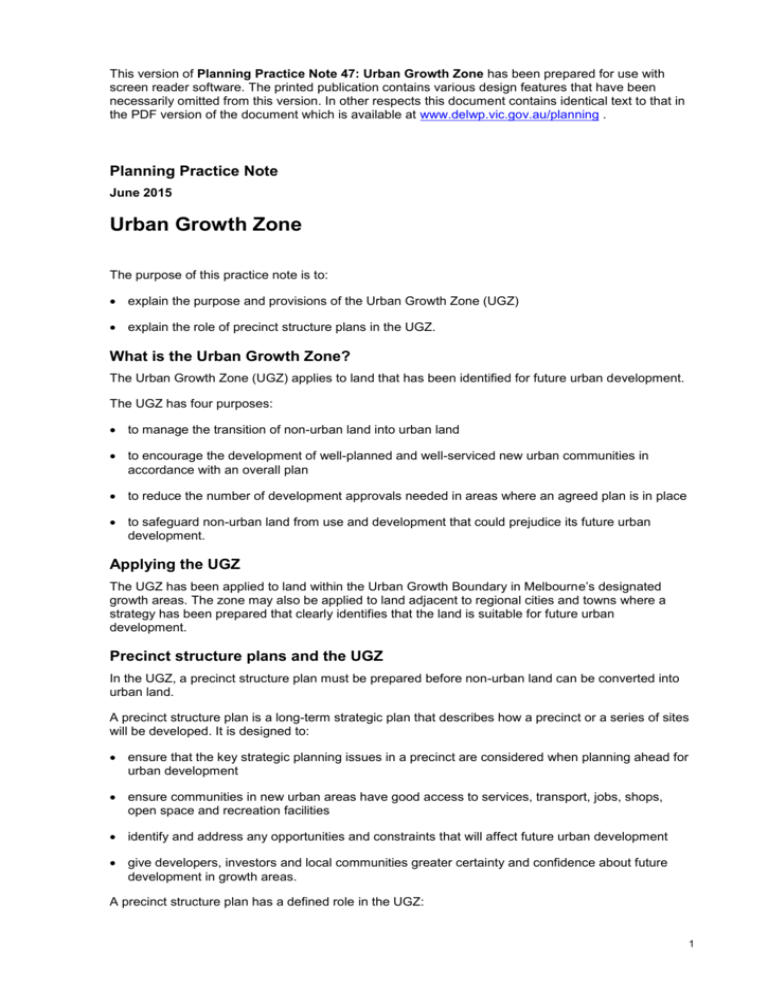
This version of Planning Practice Note 47: Urban Growth Zone has been prepared for use with screen reader software. The printed publication contains various design features that have been necessarily omitted from this version. In other respects this document contains identical text to that in the PDF version of the document which is available at www.delwp.vic.gov.au/planning . Planning Practice Note June 2015 Urban Growth Zone The purpose of this practice note is to: explain the purpose and provisions of the Urban Growth Zone (UGZ) explain the role of precinct structure plans in the UGZ. What is the Urban Growth Zone? The Urban Growth Zone (UGZ) applies to land that has been identified for future urban development. The UGZ has four purposes: to manage the transition of non-urban land into urban land to encourage the development of well-planned and well-serviced new urban communities in accordance with an overall plan to reduce the number of development approvals needed in areas where an agreed plan is in place to safeguard non-urban land from use and development that could prejudice its future urban development. Applying the UGZ The UGZ has been applied to land within the Urban Growth Boundary in Melbourne’s designated growth areas. The zone may also be applied to land adjacent to regional cities and towns where a strategy has been prepared that clearly identifies that the land is suitable for future urban development. Precinct structure plans and the UGZ In the UGZ, a precinct structure plan must be prepared before non-urban land can be converted into urban land. A precinct structure plan is a long-term strategic plan that describes how a precinct or a series of sites will be developed. It is designed to: ensure that the key strategic planning issues in a precinct are considered when planning ahead for urban development ensure communities in new urban areas have good access to services, transport, jobs, shops, open space and recreation facilities identify and address any opportunities and constraints that will affect future urban development give developers, investors and local communities greater certainty and confidence about future development in growth areas. A precinct structure plan has a defined role in the UGZ: 1 it allows the conversion of non-urban land to urban land to start sets out the vision for how land should be developed and the desired outcomes to be achieved determines the overall layout of future land use and development details the form and conditions that must be met by future land use and development determines the use and development controls that will apply in the schedule to the zone determines what permits may be granted under the zone. The application of the UGZ does not, by itself, allow urban use and development to proceed. A precinct structure plan must be prepared and applied to the land before this can occur. Before a precinct structure plan is in place, the UGZ applies provisions that are designed to safeguard the land from use or development that could prejudice its long term urban development potential. Land may be used and developed for farming and rural-related activities and urban subdivision cannot occur. Once a precinct structure plan is in place, the zone applies provisions to facilitate urban development in conformity with the plan. The zone provisions can be tailored to minimise the number of approvals required over the life of the project. Preparing and implementing a precinct structure plan The following information is relevant to preparing and implementing a precinct structure plan in the UGZ. Preparing a precinct structure plan Precinct structure planning guidelines prepared by the Growth Areas Authority provide guidance to councils, state agencies, developers, service providers and other affected parties on how to prepare a plan. The guidelines require new precinct structure plans to implement the relevant objectives for residential subdivision in Clause 56 of planning schemes. They also set out a process for precinct structure planning, a standard format for precinct structure plans, and advice about the key strategic issues to be addressed. While the guidelines contain advice relating specifically to the preparation of precinct structure plans for land in Melbourne’s growth areas, they are to be used wherever the UGZ is applied. Implementing a precinct structure plan in the planning scheme The UGZ requires a precinct structure plan to be incorporated in the planning scheme before urban development in accordance with the plan can start. The detailed use and development provisions required to implement the precinct structure plan must also be set out in the schedule to the zone. It may also be appropriate for parts of the precinct structure plan to be included in the scheme as objectives or strategies in the Municipal Strategic Statement, local planning policy, or decision guidelines. Remember that an incorporated document must be listed in the schedule to Clause 81. If a precinct structure plan includes a native vegetation precinct plan, the native vegetation precinct plan must be listed in the schedule to Clause 52.16. These actions require a planning scheme amendment, and the exhibition, submission, adoption and approval requirements of the Planning and Environment Act 1987 will apply. Implementation provisions will typically set out: use and development provisions to be included in the schedule to the UGZ (including permit requirements, permit exemptions, conditions and requirements for granting permits, advertising sign requirements, and decision guidelines) requirements for public open space contributions to be included in the schedule to Clause 52.01 of the planning scheme (if applicable) 2 requirements to implement a native vegetation precinct plan (if applicable) requirements to manage places of Aboriginal cultural heritage significance. If there is native vegetation within the precinct, a native vegetation precinct plan will need to be prepared. A native vegetation precinct plan sets out requirements for the protection and removal of native vegetation for a precinct. A native vegetation precinct plan: allows all the native vegetation issues in a precinct to be considered when planning ahead for new development helps guide the form of future development in a precinct by identifying the native vegetation to be retained and removed gives greater certainty to the council, service agencies, developers and the community about the future form of development and native vegetation management allows planning objectives for native vegetation to be integrated with recreation, urban design, and open space objectives, leading to more sustainable biodiversity and urban development outcomes streamlines the approval of appropriate native vegetation removal. A native vegetation precinct plan must meet the content requirements set out in Clause 52.16 of the planning scheme. It must also be an incorporated document under the schedule to Clause 81.01 which means that the plan can only be changed by a planning scheme amendment. Planning Practice Note 50: Preparing a native vegetation precinct plan provides guidance on preparing these plans. Preparing an amendment Minister’s Direction No. 12 applies any amendment to: rezone land to the UGZ incorporate a precinct structure plan, or change an incorporated plan, applying to land in the UGZ introduce or change a provision in a schedule to the UGZ. The direction does not apply to an amendment to make corrections. The direction requires a planning authority to evaluate and include in the explanatory report a discussion about how an amendment implements any Growth Area Framework Plan applying to the land. If the amendment proposes to incorporate or change a precinct structure plan, the planning authority must also demonstrate that the plan or any changes to it are in accordance with any applicable precinct structure plan guidelines approved by the Minister for Planning. If the amendment proposes to introduce or change provisions in a schedule to the zone, the planning authority must show in the explanatory report: how the provisions give effect to the intended outcomes of the precinct structure plan how a translation of the provisions can be achieved, once development anticipated by the precinct structure plan is substantially complete. Any other Minister’s directions applying to the amendment must also be met. Several publications provide guidance relevant to preparing a precinct structure plan or a planning scheme amendment. These are listed on page 8 and should be considered where relevant. How does the Urban Growth Zone operate? The UGZ applies different use and development provisions to land depending on whether a precinct structure plan applies or not. Part A of the zone applies when no precinct structure plan applies to the land. 3 Part B of the zone applies when a precinct structure plan applies to the land. A precinct structure plan applies to land when it is incorporated in the planning scheme. Diagram 1 illustrates how the UGZ operates at different phases in the precinct structure planning process. Diagram 2 shows the different zone provisions that apply to a planning permit application depending on whether or not a precinct structure plan applies. 4 Part A – No precinct structure plan applies Land is predominantly used for farming and other rural activities. Planning for its conversion to urban development may have commenced, but a precinct structure plan does not yet apply. The controls that apply in this case are set out in Clauses 37.07-1 to 37.07-8. Use of land The zone allows existing farming and other rural activities to continue, and new farming uses to establish, other than new saleyards and intensive animal industries. The zone also provides for permit applications for certain ‘early’ urban uses to be considered before a precinct structure plan is incorporated into the planning scheme. This is to facilitate the early provision of essential facilities and services to new residents in the precinct (for example, schools and health services), and developments essential to the marketing and construction of new urban areas (such as display homes and land sales offices). The appropriateness of these uses should be carefully considered to ensure that future plans for the land are not compromised. Before granting a permit, a responsible authority should consider: whether the preparation of a precinct structure plan for the land is sufficiently advanced the extent to which the precinct structure plan could change, and how this might impact on the proposal the amount of public scrutiny the precinct structure plan has been subject to whether it is satisfied that any conditions and requirements that would apply to the proposal once the plan applies can be met the infrastructure needs of the proposal, and how this infrastructure would be delivered and funded whether the proposal will produce acceptable outcomes in terms of the State Planning Policy Framework, the Local Planning Policy Framework, the purpose and decision guidelines of the zone, and any other decision guidelines in Clause 65 of the planning scheme. Development A permit is required to subdivide land, and a minimum lot size of 40 hectares applies. Similar to the rural zones, a permit may also be granted to create smaller lots if specific requirements are met. One of these requirements is that a section 173 agreement be entered into to constrain the further subdivision of the land. Given that the long term purpose of the UGZ is to facilitate urban development, the responsible authority should ensure that the agreement does not restrict development necessary to implement a precinct structure plan at a later date. One option is to include a provision in the agreement for its termination once a precinct structure plan applies to the land. Buildings and works controls similar to those in the Farming Zone apply. Notice and review Standard notice and review provisions apply. Referral requirement To safeguard against the granting of permits that could compromise the future urban development of Melbourne’s growth areas, the following permit applications must be referred to the Metropolitan Planning Authority under section 55 of the Planning and Environment Act 1987: an application to use or develop land for any of the following: display home education centre hospital medical centre nursing home 5 place of worship real estate agency an application to subdivide land to create a lot smaller than 40 hectares in area. These referral requirements only apply if the land is within the UGZ in metropolitan Melbourne. If the zone is to be applied to land outside metropolitan Melbourne, the planning authority should contact the relevant regional office of the department to discuss whether a section 55 referral requirement is needed. Planning Practice Note 54: Referral and Notice Provisions provides guidance on introducing new referral requirements in schemes. Advertising signs Category 4 of the advertising sign controls in Clause 52.05 applies. However, a permit may be granted, for a period of not more than five years, to display an advertising sign that promotes the sale of land or dwellings. Part B – A precinct structure plan applies Once a precinct structure plan applies to the land, different zone provisions apply. These are set out in Clauses 37.07-9 to 37.07-16 and they are designed to: provide certainty about the nature of future development reduce the number of development approvals needed once a precinct structure plan applies remove notice requirements and third party review rights from planning permit applications for proposals that generally conform to the plan ensure that permits granted for urban development generally conform to the plan. Part B allows detailed requirements to be specified in a schedule to the zone, allowing the zone to be tailored to suit the precinct structure plan. A schedule is required for each precinct structure plan. If there is more than one schedule, each schedule must be given a number. Drafting the zone schedule Before drafting the schedule to the zone, it is important that a planning authority understands the requirements that can be specified in the schedule. These are determined by the ‘parent provisions’ of the UGZ. The schedule can provide for the following: requirements for land use. These can be the requirements of a zone, specific requirements, or both requirements for buildings and works. These can be the requirements of a zone, specific requirements, or both application requirements conditions and requirements that must be applied to all permits or defined classes of permit adjustments to the exemption from notice and review decision guidelines advertising sign requirements. Schedule examples Example 1 on page 9 provides advice on how to draft a schedule. Example 2 on page 11 shows how a schedule can be drafted. When drafting a schedule, it is important that: 6 only the implementation provisions relevant to the UGZ are included in the schedule to the zone the schedule is clear about where different provisions apply, and in what circumstances. A map should be included in the schedule that shows where particular zones or provisions apply the principles of writing plain English are used when drafting provisions the land use terms and nesting concepts in Clauses 74 and 75 of the planning scheme are used the requirements of the Ministerial Direction on the Form and Content of Planning Schemes are met. Applying use and development controls A precinct structure plan can consist of a mix of land uses, for example, housing, industry and open space. Different controls may need to apply to different parts of the precinct structure plan. This can be dealt with in three ways: Option 1: The schedule can apply zones to the land, such as the General Residential Zone or Industrial 1 Zone. Option 2: The schedule can apply specific provisions to the land. Option 3: The schedule can apply zones to the land, as well as specific provisions. Option 1 – Apply zones This option involves ascribing zones to specific parts of the precinct structure plan. Land must be used and developed in accordance with the provisions of the zone applying to it. This approach is preferred because: planning scheme users are familiar with the requirements of the zones it promotes consistency in the way that planning authorities deal with particular land use issues the zones include provisions that implement State planning policy. For example, the General Residential Zone ensures that maximum use is made of Clause 56 to plan residential subdivisions the zones include provisions necessary to manage potentially conflicting land uses. For example, the Industrial 1 Zone contains specific provisions to control industrial development close to housing, schools, hospitals and other sensitive uses once development is underway, it is a straightforward task to translate the UGZ. Remember, all of the zones to be applied must be included in the scheme. Option 2 – Apply specific provisions This option may be necessary where the desired outcomes will not be achieved by applying a zone. If this approach is used, a table of uses will need to be constructed. Planning Practice Note 10: Writing Schedules provides advice on constructing a table of uses and deciding when a use should be made ‘as of right’, require a permit, or be prohibited. It should be remembered that the UGZ will eventually need to be translated to ‘standard’ zones. If the schedule contains complex or unusual specific provisions, this will make the translation task more difficult. Specific provisions will usually not be needed once development anticipated by the precinct structure plan is substantially complete. However, if this is not the case, the planning authority needs to consider how it will translate these provisions at the time it is drafting the zone schedule. Option 3 – Apply zones with specific provisions This option may be necessary where additional provisions are needed to ensure that development conforms to the precinct structure plan. 7 Providing flexibility in the PSP and UGZ schedule The precinct structure plan and UGZ schedule should be written in a way that gives the responsible authority the flexibility to consider proposals that achieve the outcomes sought by the plan without being vague or ambiguous. The UGZ schedule should also be clear about how any doubts relating to the application of provisions will be resolved. One option is to include a specific provision in the schedule that allows the responsible authority to resolve these issues through the consideration of a planning permit application. An example of this is provided in Example 2. Subdivision A permit is required to subdivide land. A permit granted must be generally in accordance with the precinct structure plan. The schedule can specify requirements that a subdivision must meet. Notice and review An application is exempt from most notice requirements and third-party review rights if it generally conforms with the precinct structure plan. The schedule to the UGZ can be drafted to remove such exemptions, if the circumstances require. Application requirements The schedule can include requirements for use and development applications. Conditions and requirements for permits The schedule can include conditions or requirements that a permit granted must include. Decision guidelines The schedule can include decision guidelines that require the responsible authority to give specific consideration to a particular issue or fact, in addition to any relevant decision guidelines in Clause 37.07-14 of the zone. Translation to standard zones Once development in a precinct structure plan commences, the UGZ will need to be translated into an appropriate standard zone. For some precinct structure plans, the certification of a subdivision for a major landholding may be an appropriate time to carry out the zone translation. Other precinct structure plans may require further development to proceed before a translation occurs. The appropriate time for zone translation should be discussed with the department. Planning publications The following publications provide guidance on planning for new urban communities, statutory planning processes and drafting statutory documents (as relevant). Precinct Structure Plan Guidelines, Growth Areas Authority, revised 2013 Victorian Coastal Strategy, Victorian Coastal Council, 2014 Publications on the department’s website: Activity Centre Design Guidelines, 2005 Development Contributions Guidelines, 2007 Guidelines for Higher Residential Development, 2004 Safer Design Guidelines, 2005 Using Victoria’s Planning System Planning practice notes: PPN46: Strategic Assessment Guidelines PPN58: Structure Planning for Activities Areas 8 PPN60: Height and Setback Controls for Activities Areas PPN10: Writing Schedules PPN13: Incorporated and Reference Documents PPN50: Preparing a Native Vegetation Precinct Plan PPN40: Using the Residential Subdivision Provisions Clause 56 – Residential Subdivision © The State of Victoria Department of Environment, Land, Water and Planning 2015 This work is licensed under a Creative Commons Attribution 4.0 International licence. You are free to re-use the work under that licence, on the condition that you credit the State of Victoria as author. The licence does not apply to any images, photographs or branding, including the Victorian Coat of Arms, the Victorian Government logo and the Department of Environment, Land, Water and Planning (DELWP) logo. To view a copy of this licence, visit http://creativecommons.org/licenses/by/4.0/ ISBN 978-1-921331-40-4 (pdf) Disclaimer This publication may be of assistance to you but the State of Victoria and its employees do not guarantee that the publication is without flaw of any kind or is wholly appropriate for your particular purposes and therefore disclaims all liability for any error, loss or other consequence which may arise from you relying on any information in this publication. Accessibility If you would like to receive this publication in an alternative format, please telephone DELWP Customer Service Centre 136 186, email customer.service@delwp.vic.gov.au, via the National Relay Service on 133 677 www.relayservice.com.au . This document is also available in Portable Document Format at www.delwp.vic.gov.au/planning Example 1: Tips for completing schedule URBAN GROWTH ZONE – SCHEDULE SCHEDULE NUMBER TO THE URBAN GROWTH ZONE Shown on the planning scheme map as UGZ(number). A number can, and should, be inserted if more than one schedule is included in the zone. If used, convert to plain text. If not used, delete. NAME OF PRECINCT STRUCTURE PLAN Inserting the name of the precinct structure plan is helpful for defining the scope of the schedule. The name must be in plain, bold text. The precinct structure plan is an incorporated document, therefore include reference to the plan in the schedule to Clause 81. 1.0 The Plan Although the precinct structure plan will be an incorporated document in the scheme, a plan showing the future overall layout of land use and development should also be inserted in the schedule. This plan should be clearly labelled and a statement about the plan should be inserted here eg. “Plan 1 shows the future urban structure proposed in the [Insert Name] Precinct Structure Plan.” 2.0 Use and development 2.1 The Land 9 The schedule must clearly state where the use and development provisions apply. A map should be used to identify this. The map should be clearly labelled and a brief statement about the map should be inserted here eg. “The use and development provisions specified in this schedule apply to land as shown in Map 1.” 2.2 Applied zone provisions The zone requires the schedule to specify requirements for land use and buildings and works. If a planning authority applies the provisions of zones this must be specified here. Clause 2.2 in Example 2 provides an example of how this can be presented. If no zones are to be applied, delete this heading and the table. 2.3 Specific provisions – Use of land If a planning authority decides not to apply the use provisions of a zone, but apply specific requirements instead, the specific requirements should be presented in a table of uses in the same format as used in the state standard zones and should follow the drafting conventions set out in Planning Practice Note 10: Writing Schedules. The table of uses can specify conditions that a Section 1 use or Section 2 use must comply with. If the planning authority requires a use to be generally in accordance with the precinct structure plan, a condition to this effect will need to be included in the table (opposite the relevant uses). If a planning authority decides to apply the use provisions of a zone, but needs to specify additional use requirements, these requirements could also be presented in a table. Clause 2.3 in Example 2 provides an example. If no specific provisions are to be specified, delete this heading. 2.4 Specific provisions – Subdivision A permit is required to subdivide land under the ‘parent provisions’ of the zone. The schedule cannot alter this. However, the schedule can specify requirements that a subdivision must meet. If no specific provisions are to be specified, delete this heading. 2.5 Specific provisions – Buildings and works The zone requires any requirements for buildings and works to be specified in the schedule. The schedule may specify that a permit is not required to construct a building or construct or carry out works (subject to any conditions), or that a permit is required. If no specific provisions are to be specified, delete this heading. 3.0 Application requirements If the planning authority has specific requirements for applications, these should be set out here. If the requirements relate only to certain classes of applications, the schedule should be drafted to make this clear. Otherwise, the information may have to be provided with every application. 4.0 Conditions and requirements for permits The zone enables the schedule to specify conditions or requirements that a permit granted must include. If these are needed they can be included here in plain text. If not, delete this heading. Care is required with specifying conditions and requirements in the schedule because once any are specified they can only be changed by a planning scheme amendment. If the conditions or requirements relate only to a certain part of the precinct or a certain type of use, building or works, the schedule should be drafted to make it clear that they must only be included on permits granted for that specific area, use or development. Otherwise, the conditions or requirements may have to be included on every permit granted. 10 5.0 Decision guidelines The zone enables the schedule to introduce additional decision guidelines. If these are needed they can be included here in plain text. If not, delete this heading. Any decision guidelines specified here should not duplicate the decision guidelines in Clause 37.07-14. 6.0 Advertising signs The schedule can vary the advertising sign requirements in Clause 37.07-16. If no variation is to be specified, delete this heading. Example 2: A completed schedule URBAN GROWTH ZONE – SCHEULE 1 URBAN GROWTH ZONE – SCHEDULE 1 SCHEDULE 1 TO THE URBAN GROWTH ZONE Shown on the planning scheme map as UGZ1 GUMNUT VALLEY PRECINCT STRUCTURE PLAN 1.0 The Plan Plan 1 shows the future urban structure proposed in the Gumnut Valley Precinct Structure Plan. 2.0 Use and development 2.1 The Land The use and development provisions specified in this schedule apply to land as shown in Map 1 of this schedule. 2.2 Applied zone provisions The provisions of the following zones in this scheme apply to the use and subdivision of land, construction of a building, and construction and carrying out of works, by reference to Map 1 of this schedule. Table 1: Applied zone provisions LAND SHOWN ON MAP 1 OF THIS SCHEDULE APPLIED ZONE PROVISIONS Residential Clause 32.08 – General Residential 1 Zone LAND SHOWN ON MAP 1 OF THIS SCHEDULE APPLIED ZONE PROVISIONS Mixed use Clause 32.04 – Mixed Use Zone LAND SHOWN ON MAP 1 OF THIS SCHEDULE APPLIED ZONE PROVISIONS Industrial Clause 33.01 – Industrial 1 Zone LAND SHOWN ON MAP 1 OF THIS SCHEDULE APPLIED ZONE PROVISIONS Business 1 Clause 34.01 – Commercial 1 Zone LAND SHOWN ON MAP 1 OF THIS SCHEDULE APPLIED ZONE PROVISIONS Business 2 Clause 34.02 – Commercial 2 Zone 2.3 Specific provisions – Use of land The following provisions apply to the use of land. 11 Table 2: Use USE REQUIREMENT Shop (other than an Adult sex bookshop) If the land is shown as Commercial 1 on Map 1 of this schedule, a permit is required to use land for a Shop if the combined leasable floor area for all shops exceeds 20,000 square metres. 2.4 Specific provisions - Buildings and works A permit is not required to construct or extent one dwelling on a lot with an area less than 300 square metres where a site is identified as a lot to be assessed against the Small Lot Housing Code via a restriction on title, and it complies with the Small Lot Housing Code incorporated pursuant to Clause 81 of the Gumnut Planning Scheme. 2.5 Specific provision – Resolution of doubt If any doubt arises as to whether a provision specified in this schedule applies to land, a permit may be granted for any use or development if the responsible authority is satisfied that the use or development is in accordance with the incorporated Gumnut Valley Precinct Structure Plan. 3.0 Conditions and requirements for permits All permits to construct a building or construct or carry out works on land adjacent to Gumnut Road must provide for a setback of 20 metres from the front boundary of the lot to enable the future widening of Gumnut Road. 4.0 Advertising signs All land shown on Map 1 is in Category 2. DOCUMENT ENDS 12
